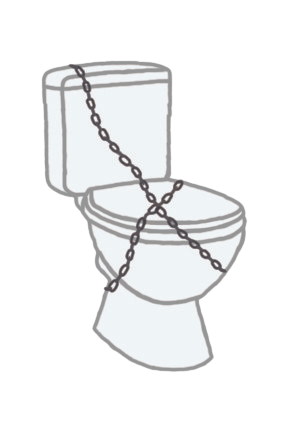
You’re speed-walking through the hallways, rushing to reach the bathroom, only to find it shut and locked. Exasperated, you now have to hurry further from your classroom just so you can use the restroom, all in the short five minutes between periods. This scenario seems to be an increasingly frequent occurrence at Western recently, one that has affected students and faculty alike. From smashed sinks to stolen ceiling tiles, bathroom destruction has become an unfortunately commonplace part of the Western experience.
The recent bathroom vandalism seems reminiscent of the “devious lick” trend that took the nation by storm two years ago, where students stole anything from basketball hoops to faucets from their schools and posted footage of the theft on social media.
Building manager Russell Napper says that while vandalism has been a prevalent issue for years, ever since he started working at Western six years ago, it has seen a recent spike. “I think the last couple of years, it’s been the worst. Last year and this year actually have been the worst as far as damage.”
Teacher Katherine Innes agrees with Napper, remarking on the increased amount of destruction around the school. “This has just been a more new phenomenon in the last five years or so…But it really has seen an uptick. And it’s not only just vandalism in the bathrooms, but more vandalism around or in disregard for property around school.”
But why is it happening? Unfortunately, as much as staff agrees on the existence of the phenomenon, there is little consensus on exactly why it is occuring.
Innes, in fact, outright questions students’ motives: “Why would you do that? Why? How is that fun?”
Exasperated, Napper just says that “Kids will be kids.”
Assistant Principal Doug Granger believes that much of the vandalism has occurred due to bathroom overcrowding. “The thing with the sinks coming off half of the time, that’s just too many kids hanging out in a bathroom. One of them will try to sit on the sink…and that pulls it off.”
However, Granger also notes that the larger-scale vandalism is usually purposeful. “The other half of the time, I think it’s people messing it up on purpose. And the reason we say that is because in those cases, it’s not just a sink, it’ll also be a urinal with a lot of trash everywhere and ceiling tiles being broken.”
The faculty’s focus appears to be less on why bathrooms are being destroyed, and more on how it can be stopped. Currently, many bathrooms are being closed to lessen the overcrowding. “With all the restrooms open there just aren’t enough adults available to monitor things well and closing them helps us monitor the remaining restrooms better.” Napper hopes that his original goal of refurbishing the restrooms will also help curb the vandalism as well. “If the bathrooms already look messed up because they’re so old, and we are in the process of remodeling a lot of the bathrooms, maybe then they’ll take better care of them.”
These acts of vandalism are having an enormous impact on the custodians jobs, usually making for a hectic work day. Napper describes it as very “frustrating”, as most of his job is consumed by replacing utilities in the bathrooms such as soap dispensers over and over again. “Two weeks ago I put five of them back in there and two days later they rip them all off again.” These monotonous tasks have become an unfortunate normalcy in Napper’s day-to-day, taking over his and the other custodians’ regular jobs. “You’re lucky if you can go through a week without anything happening.” The extra strain on their jobs has taken a toll, and some custodians have reached their breaking point. “One of my custodian was in tears one day because its the same thing over and over every day…and…one guy quit because of it.”
Closing the bathrooms is a result of the vandalism, and Napper hopes that students can understand and sympathize with the faculty. “Having the kids on the same page as the administrators and myself, it’s a big help.”
To make matters worse, Napper says that this problem seems to be county-wide and not just a Western anomaly. “I talk to my co-workers at the other schools who hold my same position, they’re going through the same thing we are.” This means that WAHS is not the only school petitioning ACPS for new supplies, therefore lengthening the waiting period between their order and arrival.
This ongoing issue is not only hurting the custodial staff, it’s hitting the students hard as well. Junior Molly Streit recognizes the reasoning behind closing the bathrooms, but says that it has had a negative effect on her learning. “Going to the bathroom between classes is close to impossible without being late because the lines are so long. Many of my classrooms are closest to the closed bathrooms, so bathroom breaks take so much longer.” This seems to be an almost universal struggle among students, with many bathrooms having been closed for weeks now. Junior Spencer Marazita shares a similar grievance, commenting on the confusion the closed bathrooms create. “It’s very annoying because I always have to guess which bathrooms are open and which are closed. It causes me to be out of class longer, missing instruction time.”
Luckily, there does seem to be an end in sight. Granger and other faculty members have noticed a decrease in vandalism recently, likely due to the counter measures put in place. “It could be because of the consequences that were given out to those that got caught. It might be because of our closer monitoring. But I also think that some of the students who were doing the damage have matured a little and realized that messing up restrooms just isn’t high school behavior.”
Whether or not bathroom destruction has slowed, the general consensus within the faculty, including Innes, seems to be that to solve the problem for good, students will have to take a more active role. “It’s going to be on the students to check their behavior and their friends behavior, they’re going to have to report it.”




